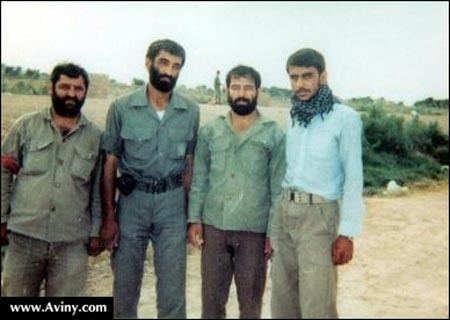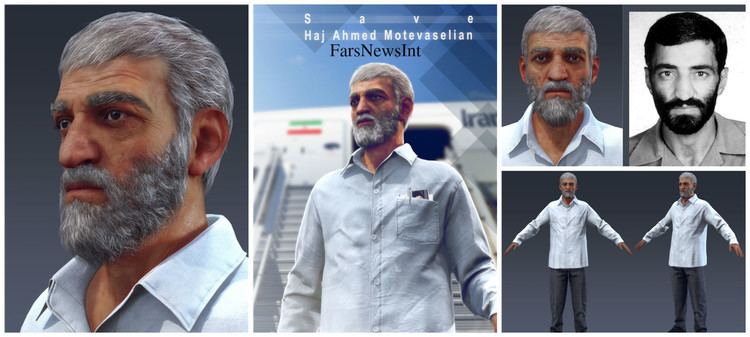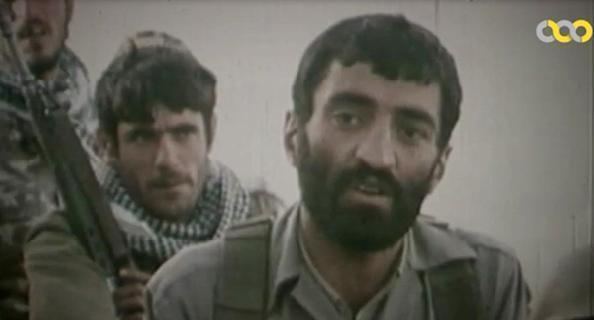Died ? | Name Ahmad Motevaselian | |
 | ||
Nickname(s) Haj Ahmad, Ahmad Motevaselian Allegiance Army of the Guardians of the Islamic Revolution Commands held Army of the Guardians of the Islamic Revolution | ||
Ahmad Motevaselian (Persian: احمد متوسلیان), an Iranian military attaché, was one of four Iranians that disappeared in Lebanon in 1982. During the Iran-Iraq war, he was a commander in the Army of the Guardians of the Islamic Revolution and established the 27th Muhammad Rasool-Allah Division of Tehran. He played a role in the Liberation of Khorramshahr and later, as part of a senior diplomatic group of political and military leaders, went to Syria. On 5 July 1982, when the vehicle carrying the diplomats was passing through a checkpoint post on its way to Beirut, it was intercepted by Phalange Party. The car and four passengers, completely disappeared.
Contents
- Early life
- Before the Iranian Revolution
- After the Iranian Revolution
- Mission in Lebanon
- Investigations
- As Tough As Iron 3
- Ambush of July 1982
- Standing in the Mist
- Ahmad Motevaselian Memorial
- References
Iran has accused Israel of kidnapping and holding them in Israeli jails and covering up their fate. Israel has said it is not aware of the fate of the diplomats. Iran called on the International Committee of the Red Cross (ICRC) to investigate their whereabouts. Three decades after the incident, the fate of the missing diplomats remains a mystery, and the search for Motevaselian and the other Iranians continues. Three decades after the incident, the fate of the missing diplomats remains a mystery but it is assumed that shortly after their abduction, they were executed by the Phalange.

Early life

Ahmad Motevaselian was born in a religious family in 1954 in the south of Tehran. He spent his primary school in Mostafavi school in Tehran. During his education, Motevaselian helped his father in his pastry shop. When he was a teenager, he participated in religious ceremonies and masque and started his political activities against the then ruling regime of Mohammad Reza Pahlavi, the Shah of Iran. After finishing his primary education, he went to industrial school and received his diploma in 1973.
Before the Iranian Revolution

After graduation, Motevaselian went to Shiraz for military service and participated in a special tank training course and was then dispatched to Sarpol-e Zahab. During his service, he continued his political activities against the Shah. After military service, he was employed in a private company and after a few months was sent to Khorramabad. In 1976, the SAVAK 'secret police' arrested him for his political activities. He was jailed for five months in solitary confinement in Falak-ol-Aflak Castle in Khorramabad. Motevaselian actively participated in the 1979 Revolution in his neighborhood and also the south of Tehran. After the victory of the Revolution, he established the Committee of the Islamic Republic in the district near his home, and later joined the Army of the Guardians of the Islamic Revolution.
After the Iranian Revolution

Following the success of the Revolution, Motevaselian engaged in various revolutionary political and military campaigns:

Mission in Lebanon
After the Liberation of Khorramshahr, Motevaselian knew that Israel had invaded Lebanon. In June 1982, he went to the Lebanese-Syrian border as head of a commando unit, but the unit was sent back to Iran by Syrian authorities but Motevaselian staid for protecting Iran's embassy from Israeli and Phalange Party. On 5 July 1982, when the vehicle carrying the diplomats was passing through a checkpoint post on its way to Beirut, it was intercepted by Phalange Party, and the car and four passengers disappeared, despite diplomatic immunity and that they were using an official state vehicle. For the last time, Iranian diplomats were seen at Barbara checkpoint that controlled by Elie Hobeika. They were then abducted by the Phalange Party. The missing diplomats are Motevaselian, military attaché and the head of the commandos of the June dispatch; Seyed Mohsen Mousavi, chargé d'affaires for the Iranian embassy in Beirut; and Taghi Rastegar Moghadam, the embassy technician; plus Kazem Akhavan, a journalist for Islamic Republic Press Agency.
Eight years later Geagea said: "they had been killed on the orders of the group's intelligence chief, Elie Hobeika." According to an Israeli report, these men were killed by Lebanese forces. Israel claimed in a statement in 2010 that the diplomats had never been surrendered to Israel. Elsewhere in response to a request by the Lebanese Hezbollah, it claimed that the four were dead. But Iran has accused Israel of kidnapping and holding them in Israeli jails and covering up their fate. Also, Iran called on the International Committee of the Red Cross (ICRC) to clarify their whereabouts. Israel has claimed that it is aware of the fate of diplomats, and that they were kidnapped by a Lebanese militant group and executed shortly after their abduction. It was believed (by whom?) that they were then buried at a site that was later obliterated by construction works.
Three decades after the incident, the fate of the missing diplomats remains locked in a debate between Iran and Israel. Apart from this debate, many scholars have assumed that shortly after their abduction, they were executed by the Phalange.
Investigations
Adnan Mansour, Lebanese foreign minister, at a meeting with the families of the abducted Iranian diplomats said: "Beirut have sent the United Nations two formal letters in the past two years confirming the abduction of the Iranian nationals on the Lebanese soil and these have been recorded as official documents at the UN Secretariat." The Lebanese justice ministry has been asked to submit a report on the latest investigations conducted into the case, vowing not to spare any effort at both national and international levels to resolve this painful issue.
Former Iranian President, Mahmoud Ahmadinejad is quoted by Iran’s Fars News Agency as telling U.N. Secretary General Ban Ki-moon during a meeting in New York City: "Regarding the four abducted Iranian diplomats, there are documents that show they are alive and in the hands of the Zionist Regime." He also added that: "We expected U.N. Secretary General to take serious measures for their release."
On 23 May 2016, Hossein Dehghan (minister of defense of Iran) stated that Ahmad Motevaselian and Iranian diplomats who disappeared in Lebanon, are alive and prisoner in the Israeli jails.
As Tough As Iron 3
The third volume of the As Tough As Iron collection is about the life of Ahmad Motevaselian, written by Zahra Rajabi Matin. This book is published by Alhoda International Publications and is published in English and Arabic. As Tough As Iron consists of seven sections; "Ahmad Motevaselian, A Man who Struggled", "Motevaselian and the Revolution Guards Corps", "Motevaselian Sent to Kurdistan", and "Motevaselian Goes to Khuzestan" are some of the book’s sections.
Ambush of July 1982
Ambush of July 1982 is calendar of events about kidnapping Iranian diplomats from 1982 to 2005, written by Hamid Davood-abadi. This is valuable book for knowing what happened to the Iranian diplomats in Lebanon. English translation of book was unveiled by the head of Foundation for the preservation of relics and values of the Holy Defense, Mohammad Bagherzadeh. The book published by Chamran Foundation and Foundation for the preservation of relics and values of the Holy Defense in 292 pages.
Standing in the Mist
Standing in the Mist is a 2015 movie about Ahmad Motevaselian. Writer and director of the film was Muhammad Hussein Mahdavian and produced by Habibollah Valinezhad. The film was selected for 34th Fajr International Film Festival.
Ahmad Motevaselian Memorial
There is a statue of Ahmad Motevaselian installed in Maroun al-Ras (Arabic: مارون الراس), a Lebanese village in Jabal Amel (Mount Amel) of the Nabatiye Governorate. The statue is a memorial and tries to demonstrate that the commander was kidnapped.
Abdol Majid Farahani, the designer of Motevaselian statue, stated: "after the studies that I had regarding the biography of Ahmad Motevaselian and talking with my friends, I decided to design the statue of this great myth in an epic condition which make the people remember him. Since Ahmad Motevaselian launched many operations in Kurdistan and due to the mountainous areas of that place, the idea of designing Ahmad near a rock was something fantastic. The pivot of the idea also is the finger pointing of Ahmad and it shows his targeting. Indeed this great character had mentioned some sentences against the Zionist regime".
